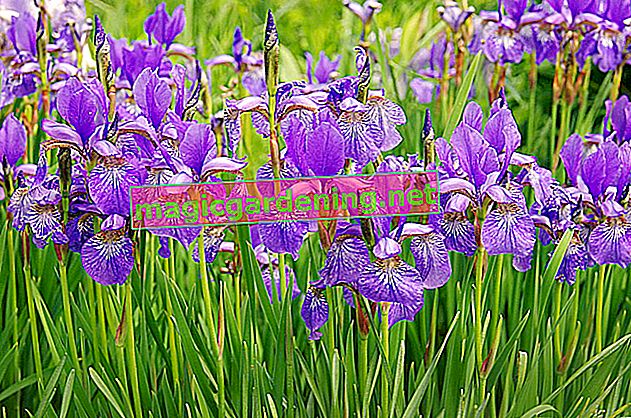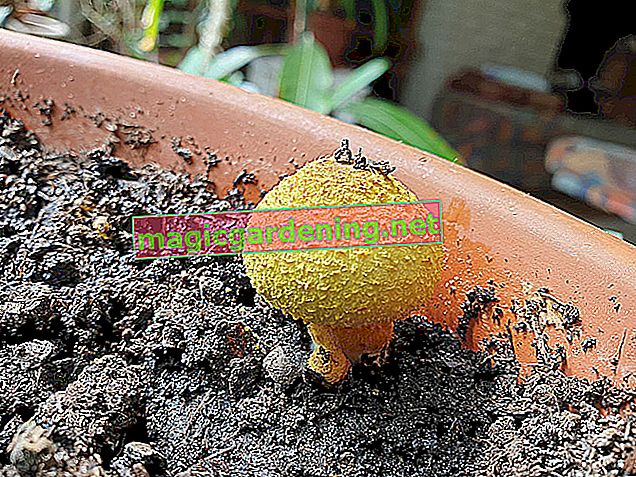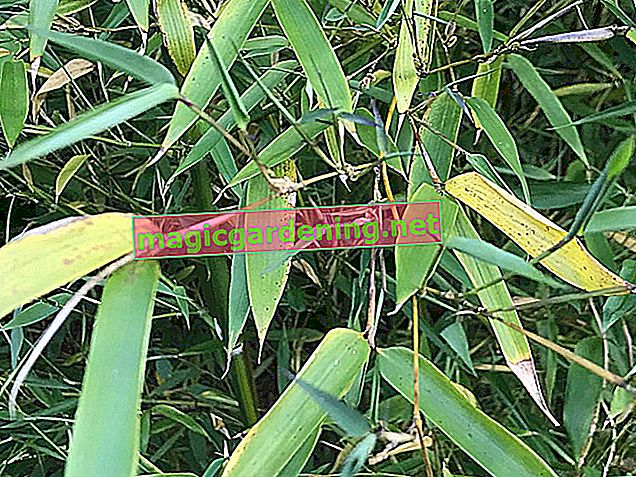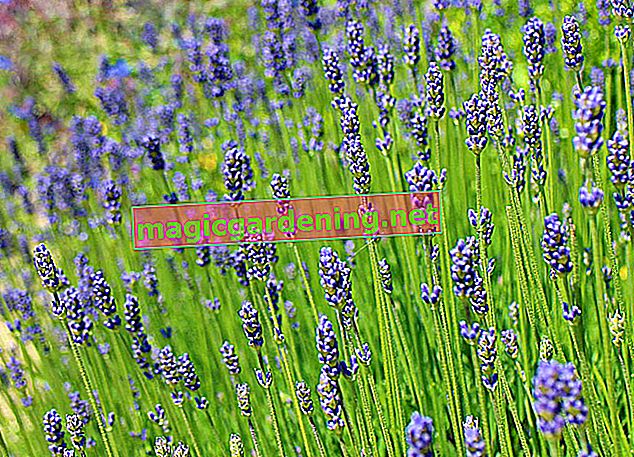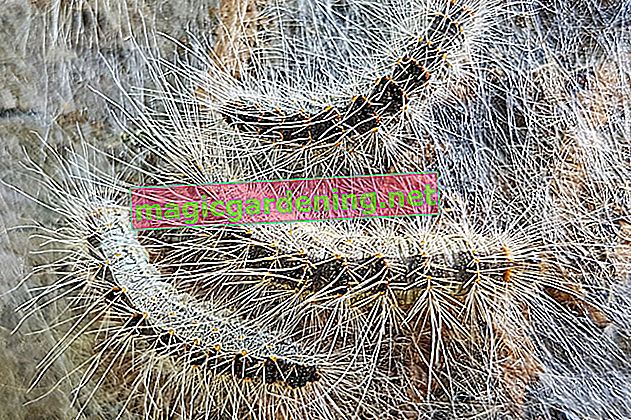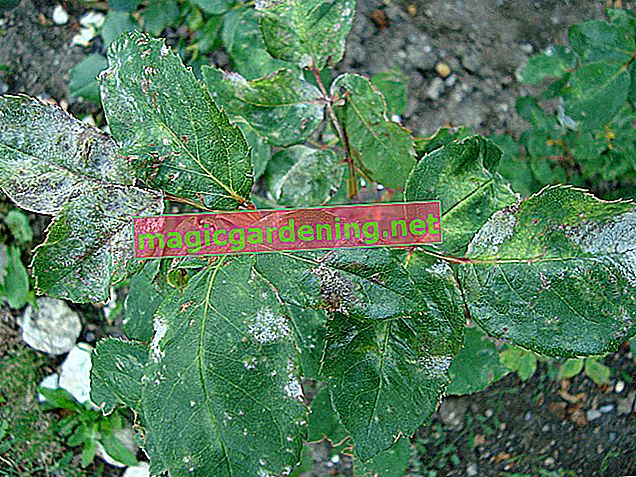
the essentials in brief
- Powdery mildew is a fair weather fungus, downy mildew a bad weather fungus
- There are many good home remedies for powdery mildew, including whole milk, field horsetail manure, tansy tea, garlic stock, and essential oils such as oregano
- Professional pruning and good care prevent powdery mildew
Real or downy mildew on roses?
also read
- Powdery mildew, star soot, rose rust - the most common leaf diseases on roses
- Identifying and combating powdery mildew on zucchini plants
- Horsetail fights powdery mildew on roses
No question about it: As soon as the leaves and shoots of your roses show the first signs of powdery mildew, you will of course want to treat the disease immediately. However, it is important to first make an accurate diagnosis. Powdery mildew is by no means the same as powdery mildew, because there are a number of different fungal pathogens. Depending on whether it is powdery mildew or downy mildew, you also need to choose the right treatment. What works against powdery mildew doesn't necessarily work against the wrong one.
The following table shows you how best to distinguish the different types of mildew from one another and which means can help against it.
| Powdery mildew | Wrong mildew | |
|---|---|---|
| Pathogen | Ashes (Erysiphaceae) | Egg mushrooms (Peronosporaceae) |
| This is how you recognize an infestation | White, flour-like coating that can be wiped off or spots on the upper side of leaves, stems and shoot tips, can also appear on flowers and buds | white to gray coating on the underside of the leaf, can also be velvety brown |
| Damage in the further course of the disease | Parts of the plant turn brown, dry up and fall off. | Parts of the plant turn brown, yellow or purple. |
| Occurs under these conditions | Fair-weather mushroom: occurs in dry weather with temperatures between 20 and 25 ° C, morning dew is dangerous, transmission by insects and wind is possible | Bad weather fungus: occurs in damp weather with temperatures between 15 and 20 ° C or in high humidity (e.g. in a greenhouse) |
| Best antidote | Spray with horsetail extract, garlic | Spray with tansy infusion, oregano, savory |
Causes of powdery mildew

Powdery mildew occurs mainly as a result of severe weather fluctuations (mainly in spring) or because the roses have not been properly cared for. Above all, too narrow a planting, incorrect watering over the leaves and nitrogenous fertilizing promote fungal diseases. Check your rose plants regularly for signs of infestation so that you can act immediately if the first symptoms appear. Powdery mildew spreads very quickly and the more pronounced the symptoms, the more difficult it is to control.
Powdery mildew on roses - what to do?
How to properly plant and care for roses and thus keep powdery mildew and other rose diseases away, you will find out in this informative article:
video: Youtube
You can only protect yourself against powdery mildew on roses by means of suitable preventive measures, which we will introduce to you further down in this text. If these don't help, try some proven home remedies first. These include a whole milk-water mixture or a soda-based spray, both of which are slightly acidic and impair the spread of the fungi. In addition, there are other very good sprays that you can make from ingredients you have collected yourself.
However, pruning back infected plant parts is essential for the success of the measures. Leaves and shoots that are already discolored will no longer get a healthy color anyway, which is why only a generous pruning will help in the event of severe infestation. Easily infected roses, on the other hand, can be treated by wiping the infected leaves with a milk mixture, supplying the plants with a tonic and, if necessary, improving the site conditions and maintenance.
Well-known home remedies for powdery mildew on roses

The two home remedies listed here are tried and tested classics that help against both real and downy mildew. It is important not to carry out the sprayings singly, but several times at intervals of a few days over a period of at least two to three weeks. Also make sure that you can dry off the rose petals and shoots quickly afterwards. It is therefore preferable to carry out the spraying in the late morning and in dry weather.

Whole milk-water mixture for spraying
The well-known milk-water mixture, with which you can also treat your roses as a preventive measure from the beginning of the growing season, has proven its worth, especially in the case of an initial to light infestation with powdery mildew. The recipe is as follows:
- If possible, use untreated whole milk (at least 3.5 percent fat content).
- Alternatively, you can also use buttermilk.
- Mix the milk in a ratio of 1: 9 with boiled and cooled water.
- It is best to use rainwater or well-stale tap water.
- Fill the mixture into a clean and disinfected spray bottle.
- Spray the powdery mildew-infested roses so hard that the sharpening agent drips from the leaves and shoots.
- In any case, don't forget to treat the underside of the leaves.
- Repeat the treatment several times a week.
Baking powder mixture
Baking soda works even better than a milk-water spray. However, do not choose just any baking powder, but rather one with baking soda. Mix a packet with two liters of water and 20 milliliters of neutral cooking oil (e.g. rapeseed or sunflower oil) and pour the mixture into a spray bottle. Treat the powdery mildew-infected plant parts several times a week.
Make your own pesticides against powdery mildew on roses
In general, chemical sprays are only very rarely actually necessary in the hobby garden. After all, there are enough effective substances in nature that can be produced inexpensively and easily by yourself. If you prefer to buy a finished product, you can fall back on the biological preparation “fungus-free”.
Horsetail against powdery mildew

Field horsetail grows almost everywhere and is often viewed as a weed and plucked out. A liquid manure made from the herb has a very stimulating effect not only on roses and very well prevents infection with powdery mildew. You can use horsetail broth - diluted with water in a ratio of 1:10 - both for prevention and for treatment in the initial stages of powdery mildew. The effect is based on the mineral salts it contains, such as silica, potassium and calcium, which make roses and other plants more resistant to powdery mildew.
Recipe for horsetail manure
- Collect one kilogram of field horsetail without roots. Alternatively, you can also use marsh horsetail.
- Chop up the plant parts.
- Put the plant material in a plastic bucket.
- Pour ten liters of cold water.
- Rainwater is best.
- Add a handful of bedrock flour.
- Stir well.
- Let the mixture stand for about 14 days, covered with a jute cloth or a piece of wire mesh (€ 14.99 on Amazon *).
- Stir twice a day.
The liquid manure is ready as soon as no more bubbles rise. Now you can filter the liquid and fill it into canisters. Spray your roses dripping wet with the agent every eight to ten days between April and August.
Garlic against powdery mildew
A garlic extract has also proven to be an effective remedy for powdery mildew. Spray the infected parts of the plant with the agent diluted with water in a ratio of 1:10 or 1:20 (depending on the severity of the infection), preferably in the evening. Repeat the application regularly.
Garlic extract recipe
- Chop 100 grams of garlic including the peel.
- Mix the garlic with three tablespoons of rapeseed oil.
- Let the mixture stand covered for 24 hours.
- Now mash the garlic and strain the liquid.
- Add a tablespoon of liquid dish soap.
- Mix the mixture well.
- Finally, pour a liter of water into the mixture.
This preparation lasts around three weeks if refrigerated and protected from the sun.
Tansy against downy mildew

The intensely yellow blooming tansy - often found on the edges of fields and roads in the summer months - makes a great spray against downy mildew as an infusion. To do this, pour one liter of hot, but no longer boiling, water over 100 grams of fresh or 20 grams of dried flowers. Let the brew steep until it has cooled to room temperature and then strain it off. Dilute the agent in a ratio of 1: 5 with water and spray infected parts of the plant with it.
Tips
In contrast to manure and extracts, infusions cannot be kept and must be used immediately.
Oregano or savory against downy mildew
Little known, but also very effective against downy mildew, are extracts from savory or oregano. Both herbs contain essential oils that the fungal pathogens do not get. For the production of such a fungicide you also need extra fine clay so that the active ingredients adhere better to the rose petals.
Recipe for a fungicide based on savory or oregano
- Chop 100 grams of fresh herb.
- Mix this with a tablespoon of canola oil.
- Let the mixture stand for 24 hours.
- Then carefully strain the escaping liquid.
- Mix this with three to four drops of liquid detergent.
- Now stir the mixture with 250 milliliters of water.
- The liquid should be homogeneous.
- Now make a clay-water mixture from a teaspoon of clay and a liter of rainwater.
- Pour both liquids into a spray bottle and shake well.
You can use this spray as needed.
Digression
Cut roses properly
Regular pruning makes roses more resistant to powdery mildew. On the one hand you cut away any overwintering fungal spores with an annual spring cut, on the other hand, the rose is more airy and therefore less endangered per se. How, how much and when you cut depends on the rose varieties and their classification.How to effectively prevent powdery mildew on roses
"For roses to stay healthy, they absolutely need an optimal location!"
However, the most effective method against all types of powdery mildew is and remains careful prevention. You should take the following tips to heart:
- Roses need a light and airy location.
- Do not plant them too closely, but keep the recommended planting distance.
- The shrubs also feel most comfortable on moist and nutrient-rich soil.
- Keep the rose bed weed-free as many weeds attract and spread fungal diseases.
- Mulch the root area of the roses with bark mulch.
- Always water roses from below and directly on the ground, never over the leaves!
- Preferably water in the morning, as watering in the evening promotes the development of fungal diseases.
Watering in the evening also has another disadvantage, because it attracts the voracious slugs.
Digression
Plant protective barrier against powdery mildew
Some herbs are powdery mildew resistant, which is why you should plant them in between the rose beds: Chervil, chives, basil and garlic act as a natural protective barrier, as do foxgloves, by the way.These rose varieties are resistant to powdery mildew
The word “resistant” implies that the rose varieties labeled in this way cannot develop fungal diseases such as powdery mildew. This is of course nonsense, as plants marked as particularly resistant to pathogens can also be infected - for example because the site conditions are not right (for example the roses are planted too closely) or have been incorrectly watered / heavily fertilized. Such conditions weaken even more robust varieties over time, making them more susceptible.
Weather influences the occurrence of rose diseases
In addition to an unsuitable location or improper care, the weather can also trigger fungal diseases - for example if the year was particularly humid. In a year in which a noticeably large number of mushrooms flourish, powdery mildew mushrooms will of course also feel very good. Nonetheless, planting a rose variety that is robust against powdery mildew makes sense because it is significantly less susceptible than many other varieties - provided, of course, the location and care conditions are right.
Choose robust ADR roses
If you want to be on the safe side, choose a so-called ADR rose if possible. These are varieties that have to pass a “Rose TÜV” and meet strict criteria before they are awarded the seal of approval. These test criteria include not only external factors such as growth and flowering, but also susceptibility to typical rose diseases or winter hardiness. In principle, ADR roses are very robust and less susceptible to powdery mildew, but by no means completely immune to disease.
Tips
ADR roses are a German seal of approval, which is why most new breeds from abroad - such as the famous English roses - are not tested. However, that doesn't mean they're not robust - they just aren't submitted for review.
frequently asked Questions
Does baking soda actually help against powdery mildew on roses?
In fact, baking soda is very effective against powdery mildew - but only if you buy a variety with baking soda (sodium hydrogen carbonate). Most of the baking powders available in Germany, however, contain other raising agents and are therefore unsuitable for the purpose of fighting powdery mildew. Soda is often available commercially under names such as baking soda, emperor soda or baking soda.
Is powdery mildew contagious to other plants?
Since powdery mildew is a fungus, regardless of whether it is “real” or “wrong”, the disease is highly contagious. If a rose has already been infected by the fungal lawn, the pathogen spreads from it to other roses and other ornamental and useful plants. This is why acting quickly and, if possible, isolating the affected plant is so important. Furthermore, plant parts infected with powdery mildew do not belong on the compost, since the spores survive and infect other plants when the finished compost is spread.
Is powdery mildew actually poisonous?
Both powdery mildew and downy mildew are poisonous. People who are allergic to fungi or penicillin are particularly at risk. These people can experience severe allergic symptoms up to and including allergic shock through contact with the powdery mildew fungus. As an allergy sufferer, you should avoid touching infested plants without protection (gloves, breathing protection if necessary). Also, do not eat contaminated parts of the plant, this can lead to problems in the gastrointestinal tract.
What does mildew tolerant mean?
Mildew-tolerant rose varieties are less susceptible to infection with the causative fungal pathogens. However, if the conditions are right, the variety in question can still become ill. Only roses that are resistant to powdery mildew do not develop powdery mildew.
Tips
Remove dried out or damaged parts of the plant as quickly as possible, as these are perfect gateways for fungal pathogens. Garden tools used for cutting roses (e.g. scissors) should also be cleaned and, if necessary, disinfected before and after each use.


